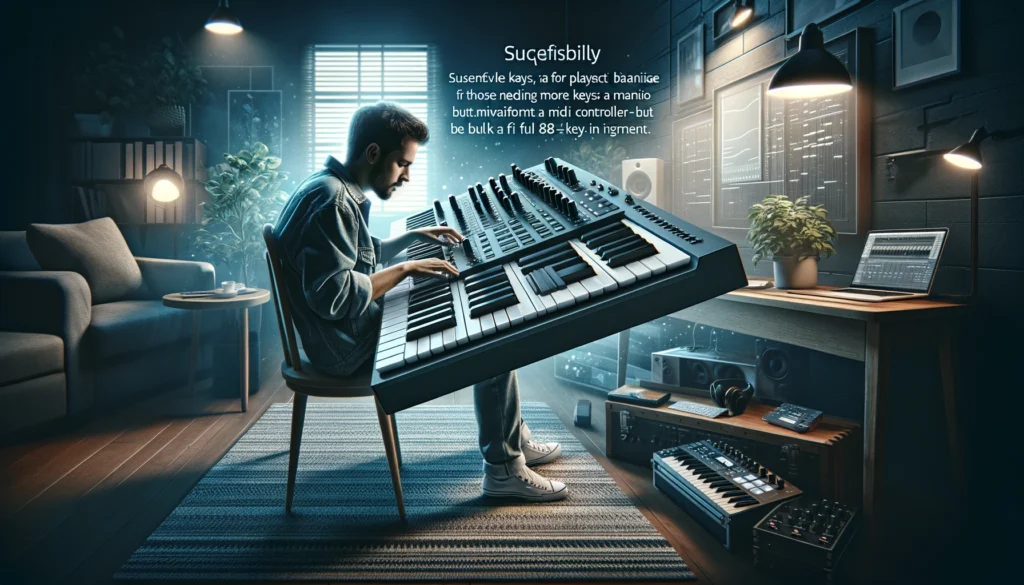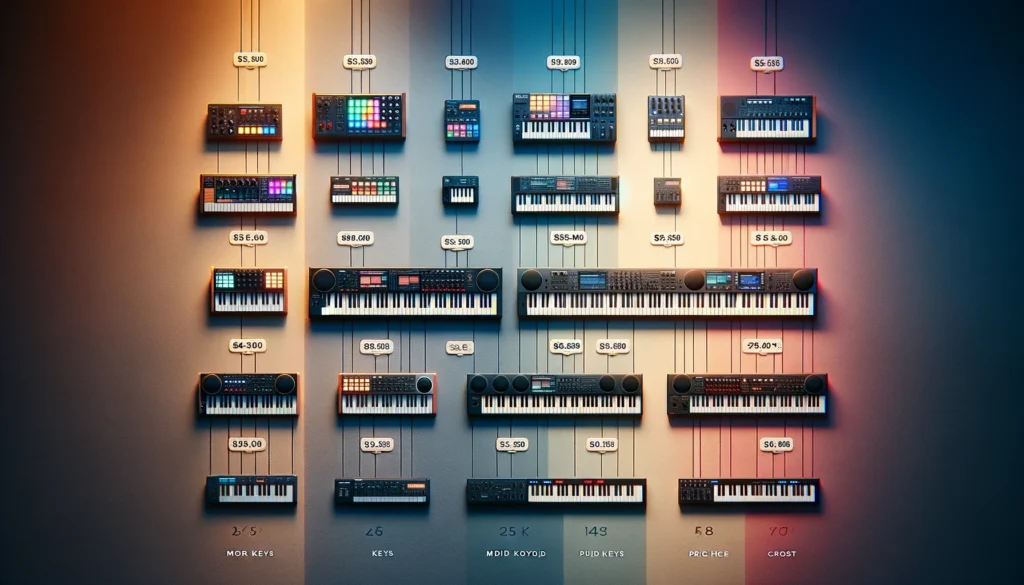If you’re in the market for a new MIDI keyboard controller, one of the first questions you’ll grapple with is “How many keys do I need?”.
With options ranging from ultra-portable 25-key models to full 88-key instruments, it can get overwhelming to determine what’s best for your situation.
The ideal number of keys comes down to a variety of factors including your usage plans, budget, sound priorities, and more.
Let’s break down the key considerations to help you select the perfect MIDI controller to match your musical needs.
Will 25 Keys Be Enough?

Getting a 25-key MIDI keyboard controller can provide substantial capability in a compact and affordable package.
For musicians focused on producing electronic music, DJing, or performing live synth parts, two octaves is often adequate.
However, for those wanting to play more complex piano arrangements, at least 49 keys is recommended.
We’ll explore this topic more below.
Consider How You Plan To Use The Controller

If you plan to use the MIDI controller primarily for piano-style playing, then getting a keyboard with at least 49 full-sized keys is recommended.
Forty-nine keys is enough to cover a little over 4 octaves, allowing you to play most piano parts without running out of range on either end.
If your main goal is to play piano-style parts and have a piano-like playing experience with your MIDI keyboard, then 49 keys or more would be ideal.
However, if you intend to use your MIDI controller more for producing electronic music, sequencing, and playing synth parts, then 25 to 49 keys may be perfectly sufficient.
Many classic synthesizers and vintage analog gear came with keyboards in this size range.
For laying down basslines, arpeggios, lead melodies, and harmonies, two or three octaves is typically enough.
Going with a more compact 25-49 key MIDI keyboard can save you space and money while still meeting your musical needs.
Finally, if you want maximum versatility out of your controller and don’t want to feel limited in any musical situation, then springing for an 88-key keyboard with full-sized keys can be worthwhile.
With a full 88 keys, you can play extremely wide-ranging piano parts as well as split the keyboard into separate zones for bass, chords, leads when producing.
It gives you the most flexibility and means you won’t quickly run out of notes during creative moments.
You will, however, sacrifice some portability compared to smaller keyboards.
Factor In Portability

If you plan on using your MIDI controller in different locations, portability may be an important consideration when deciding on key count.
Eighty-eight key MIDI keyboards with weighted keys are typically large, heavy, and more difficult to transport from place to place compared to their smaller counterparts.
If you want to be able to easily move your controller between home, the studio, or live performances, going with at least 49 keys or less may make the most sense.
On the more portable end of the spectrum, mini 25 to 32 key MIDI controllers are designed with mobility in mind.
They easily fit into a backpack or small case and are lightweight, making them very easy to take wherever musical inspiration strikes.
Just keep in mind that fewer keys limit the range of notes available for playing, which requires a bit more selectivity when playing parts.
Still, for on-the-go music production and performance, an ultra-portable mini keyboard gives you a lot of capability in a small package.
In the middle ground, 49-key MIDI controllers balance decent portability with ample note range for most situations.
The keyboards are large enough to enable varied performances while still being reasonably compact and manageable.
For musicians who want something they can take with them when needed but don’t necessarily require the smallest package possible, 49 to 61 semi-weighted keys hits a nice sweet spot between playability and mobility.
Determine Your Budget

In most cases, the more keys on a MIDI keyboard controller, the higher the price tag.
Professional 88-key controllers with fully-weighted, hammer action keys that emulate the response of an acoustic piano can cost $500 or more.
While very realistic for piano playing, this degree of authenticity comes at a premium.
Unless you really need precise weighted action for piano performances or recording piano tracks, you can likely get by with a less expensive keybed and save substantially.
On the more affordable end, there are many decent 49-key MIDI controllers available for under $200 that provide great playability.
While they may lack weighted keys, features like touch sensitivity and aftertouch allow for good expressiveness during performances.
If you just want something simple to input notes and chords into your DAW when producing, an inexpensive 25-key model may only set you back around $100 or less.
Consider what other features matter most besides key count, and determine if paying more for additional keys will be worthwhile for your intended uses or if a more basic keyboard will suffice.
Prioritize Key Feel And Response

When evaluating MIDI controllers, it’s important not to get so caught up in the number of keys that you overlook key feel and playability.
Even a large 88-note keyboard won’t be that enjoyable to play if the keys themselves feel stiff, unresponsive, or cheap.
On the flip side, a model with fewer quality keys can feel great under your fingers and encourage more inspiration and experimentation thanks to their responsiveness.
For musicians who really want to develop keyboard technique and get a realistic piano playing experience, weighted hammer-action keys are recommended.
The graded weighting makes the lower register heavier, just like on an acoustic piano, with increasing weight as you move up the keyboard.
This allows for practiced technique and control when playing dynamics.
For fast arpeggios, synth leads, and intricate solos however, a light synth-action keyboard can feel better suited.
The faster key response encourages quick playing across the range of the keyboard.
In addition to key action, also evaluate the velocity sensitivity of keyboards you are considering.
Velocity sensitivity determines how softly or strongly a note sounds when played based on how hard you strike the key.
Better keyboards offer more levels of velocity for nuanced dynamics, an important detail for emotive playing.
Aftertouch is another key expressiveness factor, meaning keys can respond to additional pressure even after the initial strike.
If you prioritize keyboard quality over sheer key count, you are likely to end up with a more playable, enjoyable MIDI controller.
Consider Available Controls

When evaluating keyboard controllers, also assess what other controls are available beyond just the keys themselves.
Larger MIDI keyboards provide more room for additional buttons, knobs, faders, pads, and other controls that expand the musical capability of the device.
For example, 88-key controllers will often have pitch and modulation wheels located to the left of the keys for further expression.
Many 76 or 61 key MIDI keyboards include LCD screens and menus for advanced customization.
With smaller 25-49 key devices, there’s less room for an array of controls.
But even compact models can still provide useful buttons for octave shifting, transport controls, program selection, and more.
Consider what you gain or lose in terms of additional controls for each size range.
If your main priority is playing keys and less concerned about tweakability, a streamlined mini keyboard may give you the essential functionality you need.
For producers who rely heavily on MIDI controllers for software control, opting for more available real estate can make sense.
In summary, deciding how many keys your next MIDI keyboard controller should have depends largely on your intended usage.
Prioritize key feel and response over sheer numbers, as a responsive and expressive 25 high-quality keys can be better than 61 cheap unresponsive ones.
Factor in your budget, space constraints, and portability needs as large keyboards do cost and weigh more.
And examine what other controls are available beyond just keys, as additional buttons, faders and pads dramatically increase the versatility of a controller.
Once you decide which factors matter most for your own style and needs, you’ll be better equipped to select the ideal MIDI keyboard.
Conclusion
In closing, carefully weigh your intended usage, budget, portability needs, and desired features when deciding how many keys your MIDI controller should have.
Focus more on playability than sheer number of keys.
If possible, try out keyboards in person at music stores to get a true feel for response and key mechanisms before buying.
Selecting the right MIDI controller with adequate keys and controls for your personal style and needs will lead to enhanced creativity, better productions, and more enjoyment with making music.
